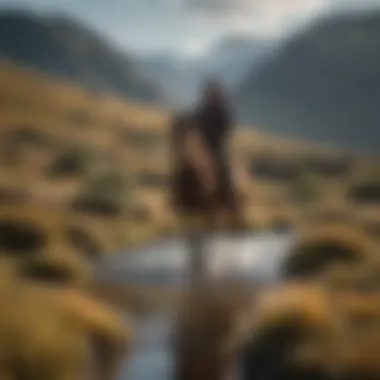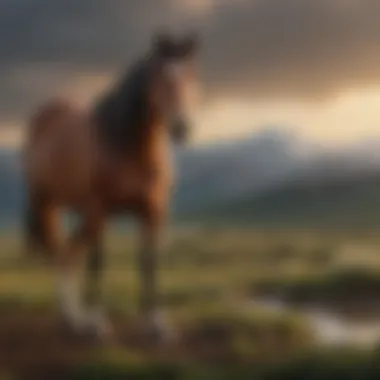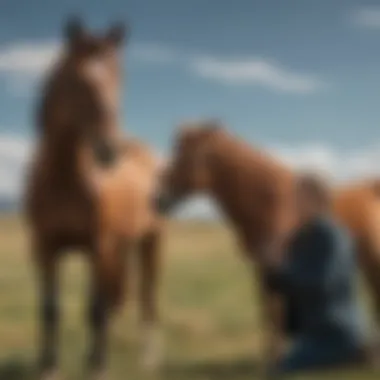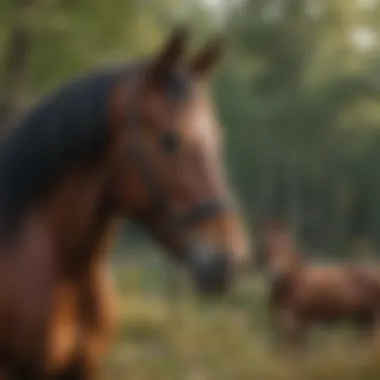Exploring Trends and Cultural Impact in New Horse Movies


Intro
The landscape of horse-themed films has undergone a significant transformation in recent years. Emerging cinematic stories portray an evolving depiction of horses that reflects modern societal values. As viewers increasingly prioritize themes like animal welfare and environmental awareness, these films become platforms for deeper discussions surrounding our relationships with animals and nature. This exploration signifies a shift in storytelling, where horses are not merely subjects of adventure, but symbols of broader issues concerning humanity and the environment.
As we dissect recent releases, various aspects become apparent. Understanding the shifts in narrative, production values, and audience reception enables us to uncover the cultural impact of these films. Moviegoers today seek narratives that resonate with their experiences and beliefs, which has led to a rise in films that address contemporary issues. Through this lens, we navigate the fascinating trends shaping the genre of horse movies and their implications in a modern context.
Fascinating Facts About the Animal
Understanding horses enriches our appreciation of their role in cinema. Horses are not just creatures of the wild; they possess unique characteristics that elevate their status in both old traditions and new stories.
Unique Characteristics
Horses exhibit remarkable diversity. Different breeds have varying traits suited for specific tasks, from the strength of a Clydesdale to the speed of a Thoroughbred. Their intelligence is noteworthy; horses can recognize human emotions and respond accordingly. This kinship with humans is crucial in films, where emotional connections drive the narrative.
Extraordinary Abilities
The physical abilities of horses are impressive. They can run at speeds over 40 miles per hour and can jump obstacles up to 8 feet high. These talents are often highlighted in movies, showcasing horses' capabilities alongside their roles in human lives. Not only do they participate in thrilling action sequences, but they also symbolize the beauty of nature and the bond formed through companionship.
Behavior and Habitat
Understanding the natural behaviors and habitats of horses reinforces their significance in filmmaking. Recent horse movies often aim to present authentic portrayals of equine life.
Natural Habitats
Wild horses typically roam in herds across vast plains, woodlands, and desert areas worldwide. Their habitat impacts their social structure, ranging from environment to breed-specific habits. Films often explore these dynamics, showcasing how horses adapt and thrive in different settings, which adds depth to the story.
Social Structures
Horses have intricate social structures. They form strong bonds within their herds, establishing hierarchies that dictate behavior. This aspect is crucial in films, where the portrayal of horse relationships reflects human themes of loyalty, courage, and community. Many narratives focus on the development of these bonds, emphasizing the emotional connections between horses and their human counterparts.
Recent Scientific Discoveries
New research sheds light on the understanding of equine behavior and biology, which can influence film narratives.
Latest Research Findings
Recent studies have indicated that horses have complex communication systems, employing vocalizations and body language. This knowledge expands how filmmakers portray horse interactions. Such insights make the animations and dialogues more realistic, enhancing audience engagement.
Breakthroughs in Animal Biology
Advancements in genetics and animal behavior are reshaping our perspective on horse training and treatment. Films now emphasize the importance of humane training and care for horses, aligning with growing public concern for animal rights and welfare. These changes in perspective are reflected in narrative choices, highlighting compassion and respect in human-animal relationships.
Cultural Significance
Horse movies hold profound cultural significance, connecting folklore, art, and literature. Their narratives often rely on longstanding traditions that value the horse as a symbol of freedom and companionship.
Animals in Folklore
Historically, horses appear in various cultural tales, symbolizing strength and loyalty. Many modern films draw inspiration from these legends and incorporate traditional themes, creating rich cultural tapestries that honor equine history.
Influence on Art and Literature
The presence of horses in art and literature contributes to their cultural status. Such portrayals often emphasize qualities like grace and power. With the rise of new horse films, these artistic influences continue to inspire filmmakers, shaping stories that resonate with the audience's values while paying homage to the animal’s legacy.


The ongoing evolution in horse-themed cinema reflects an active engagement with contemporary issues, intertwining narratives of the past with messages that resonate today.
As the cinema landscape continues to shift, the portrayal of horses will likely evolve further. The cultural significance and relevance of horse films emphasize not just the beauty of the animal but also the broader implications of our relationship with them.
In summary, exploring new horse movies enables a deeper understanding of how these films engage with modern societal values. As they bring forth themes of animal welfare and environmental consciousness, they lift horses from the background into the center of meaningful conversations.
Preface to New Horse Movies
The exploration of new horse movies opens a significant dialogue within both cinematic and social contexts. These films serve not only as entertainment but also as reflections of current societal values. They illustrate how our understanding of the human-animal bond has evolved, particularly in the realm of equines. This section aims to set the stage for a deeper analysis of trends and cultural impacts surrounding recent horse films.
The importance of this topic lies in its multifaceted nature. Understanding how horse movies resonate with audiences today requires an examination of the historical context that shaped them. It also necessitates a look at how contemporary issues such as animal welfare and environmental concerns manifest in these narratives. Through this lens, we gain insights into the changing perceptions of horses in society and their representation in film.
Historical Context of Horse Movies
Horse films have a rich history that dates back to the early days of cinema. From classic movies like National Velvet to modern productions, these films have often mirrored societal attitudes towards horses and animals in general. In the earlier decades, horses were predominantly seen through the lens of adventure and sport. Films glorified their speed and strength, reflecting a society that valued animal prowess in competition and leisure.
As times changed, so did the portrayal of horses in film. The increase in awareness surrounding animal rights and welfare began to influence storytelling. More recent films tend to explore the emotional connections between humans and horses. They portray equines not merely as animals but as sentient beings deserving of respect and care.
Current Landscape of Horse Cinema
Today, the landscape of horse cinema exhibits a diverse array of genres and themes. New releases offer fresh perspectives on traditional narratives, focusing on the bond between humans and horses. These films often explore deeper emotional connections, tackling themes like friendship, compassion, and healing. The audience is increasingly aware of the ethical considerations surrounding animal portrayal in films.
Moreover, technological advancements have transformed filmmaking. Modern cameras capture the intricate details of horses and landscapes, enhancing the visual experience. Films like Spirit: Stallion of the Cimarron and War Horse highlight these innovations in filmmaking, using rich imagery to tell compelling stories.
The development of horse movies today is a result of cultural shifts. They reflect a society that values the welfare of animals and fosters understanding. As such, these films not only entertain but also educate, providing audiences with a platform to engage with broader ethical considerations.
Notable Recent Horse Movie Releases
The emergence of new horse-themed films signifies a critical juncture in the cinematic narrative surrounding equine life. This section explores the significance of recent releases and their contributions to the genre. By focusing on notable films, we reveal not only shifts in storytelling but also the evolving public interest in horses. These films often reflect deeper themes, including animal welfare, connection to nature, and personal growth. In this context, notable recent horse movie releases embody both entertainment and educational opportunities.
Overview of Selected Films
Several films have recently captured the attention of audiences and critics alike. Each film offers a unique perspective on horses and their relationships with humans. Notable examples include:
- Wildlife United: This touching narrative follows a young girl who adopts an injured wild horse. It explores themes of resilience and rehabilitation, reflecting societal sentiments regarding animal welfare.
- Where the Hoof Prints End: A breathtaking tale of three friends embarking on a cross-country equestrian journey. It highlights both the physical and emotional challenges faced by riders.
- Galloping Towards Tomorrow: Set against a backdrop of environmental activism, this film portrays the bond between a horse trainer and a rescue horse while working to protect their local ecosystem.
These films not only entertain but also invite conversations about the role of horses in our lives. They provide a fresh lens through which to examine human-animal relationships, fostering empathy and understanding.
Critical Reception and Box Office Performance
The critical reception of recent horse movies reveals much about audience expectations and cultural relevance. Take, for example, Wildlife United. Critics praised its authentic depiction of the recovery journey, which resonated with viewers. The film's box office performance exceeded initial projections, indicating a strong appetite for genuine stories that center on animal care and conservation.
In contrast, films such as Where the Hoof Prints End garnered mixed reviews. While audiences appreciated the adventure, some criticized the predictable plot. However, it still performed well at the box office, demonstrating that adventure combined with equine elements retains its commercial appeal.
In summary, the performance and reception of these films indicate trends in viewer preferences. They reflect a broader movement toward narratives that resonate emotionally while also addressing pressing social issues. Horse movies, today more than ever, serve as a mirror to our evolving relationships with animals and the environment.
Themes and Motifs in Modern Horse Films
The exploration of themes and motifs in modern horse films is crucial in understanding their cultural significance and emotional resonance. These films often reflect deeper societal values and trends, making them not simply entertainment, but rather a mirror to our collective consciousness. Moreover, the themes presented engage audiences on multiple levels, appealing to diverse demographics ranging from families to professionals in veterinary and conservation fields. By examining these themes, we uncover the layers of connection people have with horses and the narratives that surround them.
The Human-Animal Connection
One of the most profound themes found in modern horse films is the human-animal connection. This motif appears in various forms, ranging from a simple companionship to a deep-rooted collaboration that showcases mutual respect and understanding. Films such as The Black Stallion and Seabiscuit illustrate how horses can embody qualities that resonate with human experiences like resilience, trust, and loyalty.


The emotional bond shared between characters and their equine partners often serves as a narrative catalyst, propelling the story forward and establishing significant turning points. Families can find relatable lessons in these relationships, as they often mirror the complexities present in human friendships and familial bonds. In this way, these films promote the importance of empathy and understanding, making souls connected on screen and inspiring audiences to appreciate their own connections in life.
Exploration of Adventure and Journeys
Adventure and journeys are common narratives in modern horse cinema. These elements often symbolize a character's personal growth or journey of self-discovery. For instance, in Spirit: Stallion of the Cimarron, the journey of Spirit reflects themes of freedom and identity amidst hardship. The backdrop of wide landscapes and untamed adventures captivates the audience, allowing them to experience the excitement of exploration.
Such movies tend to take viewers on vivid visual travels, showcasing not only the beauty of the equine world but also the transformative power of adventure. These themes resonate with audiences by evoking a sense of wanderlust and possibility. As a result, these films often encourage viewers to consider their own life's adventures and the roads they take toward growth.
Conservation and Animal Welfare Themes
In contemporary horse films, there's a noticeable shift toward emphasizing conservation and animal welfare themes. Filmmakers increasingly portray the challenges faced by horses and other wildlife due to environmental degradation and human interference. Movies like Narnia: The Lion, The Witch and The Wardrobe illustrate symbols of hope and ecological balance, fostering awareness on the importance of preserving both natural habitats and the animals that reside within them.
Additionally, by shedding light on issues such as rescue, rehabilitation, and responsible ownership, these films promote the idea of advocacy for equine welfare. The narratives encourage audiences to take an active role in supporting animal rights organizations and understanding the responsibilities involved in caring for animals. Education and inspiration come together in these powerful stories, paving the way for a more compassionate society.
The Role of Technology in Horse Filmmaking
The integration of technology in horse filmmaking has transformed the way stories are told in this genre. Advances in digital technology allow filmmakers to create more realistic and engaging representations of horses and their interactions with humans. This section highlights not only the cutting-edge tools but also how they contribute to the art and impact of horse movies.
Advancements in CGI and Animation
Computer-generated imagery (CGI) has become a vital tool in modern filmmaking. The portrayal of horses on screen is no longer limited to live-action shots. CGI enables filmmakers to depict scenarios that would be difficult or impossible to achieve practically. For instance, creating sweeping vistas and complicated action scenes become easier with the help of animation.
CGI also allows for better visual effects. In films such as Spirit: Stallion of the Cimarron, horses can express a range of emotions through animation, crafting a deeper emotional connection with the audience. Moreover, the quality of CGI has improved significantly, making horses look more lifelike. This requires a mix of artistry and technical precision, showcasing the talents of animators and visual effects teams who strive for realism.
"Digital effects have revolutionized how we see equine characteristics in movies, making them more expressive and dynamic than ever before."
Impact of Modern Filming Techniques
Techniques such as drone photography and stabilized rigs have also enhanced the visuals in horse films. Drones provide unique aerial perspectives that can capture the elegance of horses in motion across varied landscapes. This type of footage creates a more immersive experience, engaging viewers in a way traditional filming could not.
Stabilized camera systems enable filmmakers to follow galloping horses closely. This increases the thrill factor in action scenes while presenting horse behavior with greater accuracy. By showcasing horses in natural settings, filmmakers can emphasize the relationship between horse and rider or horse in the wild.
In using these modern techniques, filmmakers not only elevate storytelling but also improve the educational aspects of horse films. Accurate portrayals of horse behavior and the environment help inform audiences about equine care and welfare.
Overall, technology's role in horse filmmaking is critical. It not only enriches the viewing experience but also deepens the understanding of horses and their significance in both culture and nature.
Cultural Impact of New Horse Movies
Horse movies have long been a vehicle for storytelling, reflecting broader societal values and concerns. The cultural impact of new horse films goes beyond entertainment; these productions often shape public discourse around critical issues such as equine welfare, environmental sustainability, and the human-animal bond. By examining how recent films resonate with audiences, it becomes clear that they serve both as a mirror and a catalyst for change in society.
Influence on Equine Advocacy and Welfare
Recent horse films have taken a significant step in promoting equine advocacy and welfare. Many new productions portray the realities of horse breeding, training, and the challenges that horses face in various environments. This increased awareness can foster a deeper understanding of horses not merely as companions but as sentient beings requiring proper care and respect.
By addressing topics like rescue operations, rehabilitation, and responsible ownership, filmmakers can impact viewers’ perceptions and promote more ethical treatment of horses. For instance, movies highlighting the stories of abused or neglected horses and their eventual rescue serve to inspire advocacy efforts.
Audience Engagement and Demographics
In the context of contemporary horse cinema, understanding audience engagement and demographics is vital. This segment takes a closer look at the viewers who are attracted to new horse movies. Recognizing these elements allows filmmakers and marketers to tailor their approaches effectively, leading to increased relevance and success in the industry. Additionally, it becomes apparent how diverse audiences respond to and shape the narrative surrounding horses in film.
Who Watches New Horse Movies?
The audience for new horse movies is surprisingly varied. While horse enthusiasts of all ages certainly form a significant portion of the viewership, research shows that families are crucial viewers. Parents often seek films that can serve as entertaining yet educational experiences for their children. This aspect is essential in promoting themes around animal welfare and the human-animal bond, which can resonate well with younger audiences.


Moreover, a growing segment of the audience includes those interested in environmental themes reflected in horse films. Many viewers are eager to explore narratives that address issues such as conservation and wildlife preservation, appealing to their values.
A survey conducted revealed the following demographics:
- Age Range: Predominantly children and young adults, but also includes older adults who have a lifelong passion for horses.
- Interests: Animal welfare, adventure, and stories showcasing the bond between humans and animals.
- Gender: More female viewers, often due to both intimacy and nurturing themes present in horse movies.
Community and Fan Performances
Community involvement plays a significant role in the engagement with new horse films. Fans often gather through various platforms such as forums and social media to discuss their favorite films. They examine the narratives, critique the filmmaking techniques, and express their interests in the representations of horses.
Equally important are the local events. Film screenings and community discussions are fruitful opportunities for fans to come together and celebrate their shared passion. Horse movies serve as a bridge, connecting individuals who may not have met otherwise. This fosters a sense of community and belonging.
Additionally, fan performances such as reenactments of scenes or themed events tied to popular horse films have emerged. Social media sites like Facebook and Reddit provide platforms where enthusiasts can share their creative expressions and foster engagement. Such engagement often leads to increased visibility and support for future horse projects. Notably, these interactions can contribute to advocacy efforts, using the emotional narratives in films to further discussions around animal welfare and conservation.
In summary, understanding the audience who watches new horse movies enriches the narratives explored. Community engagement provides a lens into what resonates with viewers, ultimately shaping the future of horse films.
Future Trends in Horse Cinema
The landscape of horse cinema is on the verge of transformation. The examination of future trends in this genre is essential for understanding how these films will adapt in response to evolving societal norms and technological innovations. This section highlights emerging storylines and characters, as well as expected changes in the industry, providing insight into what audiences can anticipate.
Emerging Storylines and Characters
Modern horse movies are increasingly prioritizing diverse and nuanced storytelling. This includes featuring strong, well-developed characters of various backgrounds. For instance, films are beginning to focus on underrepresented groups in storytelling. These narratives often explore themes of resilience, identity, and the bonds forged between humans and horses.
As the genre evolves, a shift towards environmental themes related to equine culture is also emerging. Stories are not just about competitions or adventures but are weaving in narratives about conservation and the relationship between horses and their habitats.
- Films may incorporate:
- Urban settings that showcase horse rescue initiatives.
- Historical contexts that reveal the role of horses in different cultures.
- Personal growth journeys, emphasizing character development through horse interaction.
This broader scope allows filmmakers to create compelling narratives that resonate with diverse audiences, enriching the cultural tapestry of horse cinema.
Expected Industry Changes
The industry is ripe for significant changes in how horse movies are produced and marketed. One key area of change lies in the use of technology. With advanced CGI and animation becoming more affordable and accessible, filmmakers can depict more realistic equine movements and interactions. This has the potential to enhance storytelling, making the films visually captivating while still preserving authenticity.
Furthermore, distribution methods are adapting to digital platforms. As streaming services gain popularity, films can reach wider audiences without the constraints of traditional box office releases. This can foster a more engaged viewer community, potentially increasing the demand for films that incorporate realistic themes around horse welfare and advocacy.
As the viewing habits shift, filmmakers will face pressure to produce content that not only entertains but educates. This could lead to collaborations with organizations focused on animal welfare and environmental issues.
"The future of horse cinema depends not merely on the plots, but on the amount of authenticity a film can deliver through every frame."
In summary, future trends in horse cinema point towards a more inclusive and thoughtful approach to storytelling, utilizing technology to enhance viewer experience and engagement. As these trends develop, they carry the potential to create meaningful connections between horses, humans, and wider societal issues.
Epilogue
The exploration of new horse movies highlights the evolution of cinema in reflecting societal shifts. The films within this genre do not merely entertain; they also challenge, inform, and engage audiences on multiple levels.
Summary of Key Insights
Through the analysis presented in this article, several key insights emerge:
- Societal Reflection: New horse movies often mirror contemporary values such as animal welfare and environmental issues, making them relevant to modern audiences.
- Production Quality: The advancement in technology has considerably improved the visual and narrative quality of equine films, allowing filmmakers to depict horses with greater authenticity.
- Diverse Themes: Themes surrounding the human-animal bond and adventures have seen a rise, underlining the emotional connections that resonate with families and horse enthusiasts alike.
Final Thoughts on the Future of Horse Films
Looking ahead, the future of horse films appears promising. As society continues to evolve, these movies will likely adapt to incorporate new storylines and issues that reflect changing attitudes towards animals and nature.
- Emerging Storylines: The next generation of horse films may delve into more complex narratives, considering ethical dilemmas and the intricacies of human-animal relationships.
- Increased Inclusivity: Expect greater representation in storytelling, ensuring varied perspectives and experiences are highlighted.
- Global Appeal: As horse culture exists worldwide, there will be potential for cross-cultural narratives that can attract a broader audience.





